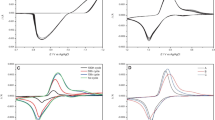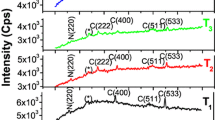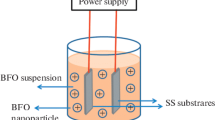Abstract
The method of electrically switched ion exchange (ESIX) involves the sequential application of reduction and oxidation potentials to an ion exchange film to induce the respective loading and unloading of Cs+. In this study, four films of nickel hexacyanoferrate were prepared on nickel electrodes with different preparation procedures. Films were characterized by SEM/EDX. Each film shows a different performance with regard to Cs+ separation. Scanning electron microscopy was used to characterize the modified film surfaces. Cyclic voltammetry was used to investigate the ion exchange capacity and stability. The four films show a better capacity for Cs+ separation compared to previous methods for the deposition of ESIX films. An optimal nickel hexacyanoferrate film was generated when using an applied potential of 0.2 V relative to a saturated calomel electrode (SCE) to generate the nucleation sites, followed by a 1.3 V vs. SCE potential during the growth stage of the film. This film demonstrated the highest film capacity for ion exchange initially (17.3 × 10−3 C cm−2) and again after 1000 cycles (11.1 × 10−3 C cm−2).





Similar content being viewed by others
References
Anthony RG, Gu D, Philip C, Dosch R (1994) Use of silicotitanates for removing cesium and strontium from defense waste. Ind Eng Chem Res 33:2702–2705
Green-Pedersen H, Korshin GV (1999) Separation of cesium from high ionic strength solutions using a cobalt hexacyanoferrate-modified graphite electrode. Environ Sci Technol 33:2633–2637
Mcdowell WJ, Case GN, Mcdonough JA, Bartsch RA (1992) Selective extraction of cesium from acidic nitrate solutions with didodecylnaphthalenesulfonic acid synergized with bis (tert-butylbenzo)-21-crown-7. Anal Chem 64:3013–3017
Law JD, Herbst RS, Todd TA, Romanovskiy VN, Babain VA, Esimantovskiy VM, Smirnov IV, Zaitsev BN (2001) The universal solvent extraction (UNEX) process. II. Flowsheet development and demonstration of the UNEX process for the separation of cesium, strontium, and actinides from actual acidic radioactive waste. Solvent Extr Ion Exc 19:23–36
Romanovskiy VN, Smirnov IV, Babain VA, Todd TA, Herbst RS, Law JD, Brewer KN (2001) The universal solvent extraction (UNEX) process. I. Development of the UNEX process solvent for the separation of cesium, strontium, and the actinides from acidic radioactive waste. S Solvent Extr Ion Exc 19:1–21
Mohapatra P, Lakshmi D, Bhattacharyya A, Manchanda V (2009) Evaluation of polymer inclusion membranes containing crown ethers for selective cesium separation from nuclear waste solution. J Hazard Mater 169:472–479
Mohapatra P, Bhattacharyya A, Manchanda V (2010) Selective separation of radio-cesium from acidic solutions using supported liquid membrane containing chlorinated cobalt dicarbollide (CCD) in phenyltrifluoromethyl sulphone (PTMS). J Hazard Mater 181:679–685
Sinha P, Panicker P, Amalraj R, Krishnasamy V (1995) Treatment of radioactive liquid waste containing caesium by indigenously available synthetic zeolites: a comparative study. Waste Manag 15:149–157
Shakir K, Sohsah M, Soliman M (2007) Removal of cesium from aqueous solutions and radioactive waste simulants by coprecipitate flotation. Sep Purif Technol 54:373–381
Borai E, Harjula R, Paajanen A (2009) Efficient removal of cesium from low-level radioactive liquid waste using natural and impregnated zeolite minerals. J Hazard Mater 172:416–422
Someda H, Elzahhar A, Shehata M, El-Naggar H (2002) Supporting of some ferrocyanides on polyacrylonitrile (PAN) binding polymer and their application for cesium treatment. Sep Purif Technol 29:53–61
Roy K, Pal D, Basu S, Nayak D, Lahiri S (2002) Synthesis of a new ion exchanger, zirconium vanadate, and its application to the separation of barium and cesium radionuclides at tracer levels. Appl Radiat Isot 57:471–474
Li N, Li Z, Yuan J, Hu J, Miao J, Zhang Q, Niu L, Song J (2012) Nickel hexacyanoferrate nanoparticles anchored to multiwalled carbon nanotubes with a grafted poly (4-vinylpyridine) linker for electrically switched ion exchange. Electrochim Acta 72:150–156
Rassat SD, Sukamto JH, Orth RJ, Lilga MA, Hallen RT (1999) Development of an electrically switched ion exchange process for selective ion separations. Sep Purif Technol 15:207–222
Hao X-G, Guo J-X, Liu S-B, Sun Y-P (2006) Electrochemically switched ion exchange performances of capillary deposited nickel hexacyanoferrate thin films. Trans Nonferrous Met Soc China 16:556–561
Reyes-Gomez J, Medina JA, Jeerage KM, Steen WA, Schwartz DT (2004) High capacity SiO2-graphite composite electrodes with chemically incorporated metal MHCFs for electrochemically switched alkaline cation exchange. J Electrochem Soc 151:D87–D92
Hao X, Li Y, Pritzker M (2008) Pulsed electrodeposition of nickel hexacyanoferrate films for electrochemically switched ion exchange. Sep Purif Technol 63:407–414
Tanihara K (1994) A new process using a redox type of ion exchanger for cesium separation: I. A sorption-desorption-regeneration cycle with insoluble hexacyanoferrates of copper. J Radioanal Nucl Chem 185:57–67
Steen WA, Han S-W, Yu Q, Gordon RA, Cross JO, Stern EA, Seidler GT, Jeerage KM, Schwartz DT (2002) Structure of cathodically deposited nickel hexacyanoferrate thin films using XRD and EXAFS. Langmuir 18:7714–7721
Lilga MA, Orth RJ, Sukamto J, Haight S, Schwartz D (1997) Metal ion separations using electrically switched ion exchange. Sep Purif Technol 11:147–158
Bin S, Xiaogang H, Zhongde W, Zhang Z, Shibin L, Guoqing G (2012) Continuous separation of cesium based on NiHCF/PTCF electrode by electrochemically switched ion exchange. Chin J Chem Eng 20:837–842
Lilga MA, Orth RJ, Sukamto JP, Rassat SD, Genders JD, Gopal R (2001) Cesium separation using electrically switched ion exchange. Sep Purif Technol 24:451–466
Bocarsly AB, Sinha S (1982) Effects of surface structure on electrode charge transfer properties: induction of ion selectivity at the chemically derivatized interface. J electro chem interfacial electrochem 140:167–172
Bocarsly AB, Sinha S (1982) Chemically-derivatized nickel surfaces: synthesis of a new class of stable electrode interfaces. J electro chem interfacial electrochem 137:157–162
Soto MB, Scholz F (2002) The thermodynamics of the insertion electrochemistry of solid metal hexacyanometallates. J Electroanal Chem 521:183–189
Zanello P (2003) Inorganic electrochemistry: theory, practice and applications
Fisher AC. Liner sweep and cyclic voltametry: the principles (2010), http://www.ceb.cam.ac.uk/research/groups/rg-eme/teaching-notes. [cited 2017]
Scholz F, Dostal A (1996) The formal potentials of solid metal hexacyanometalates. Angewandte Chemie International 34:2685–2687
Brownson DA, Banks CE (2014) The handbook of graphene electrochemistry
Prodromidis MI, Florou AB, Tzouwara-Karayanni SM, Karayannis MI (2000) The importance of surface coverage in the electrochemical study of chemically modified electrodes. Electroanalysis 12:1498–1501
Acknowledgements
The authors would like to thank the Egyptian Armed Force and the Natural Science and Engineering Research Council of Canada (NSERC) (Discovery Grants Program) for supporting this work.
Author information
Authors and Affiliations
Corresponding author
Rights and permissions
About this article
Cite this article
Tawfic, A.F., Dickson, S.E., Kim, Y. et al. Preparation and characterization of nickel hexacyanoferrate films for the removal of cesium ion by electrically switched ion exchange (ESIX). J Solid State Electrochem 21, 2939–2946 (2017). https://doi.org/10.1007/s10008-017-3635-y
Received:
Revised:
Accepted:
Published:
Issue Date:
DOI: https://doi.org/10.1007/s10008-017-3635-y




